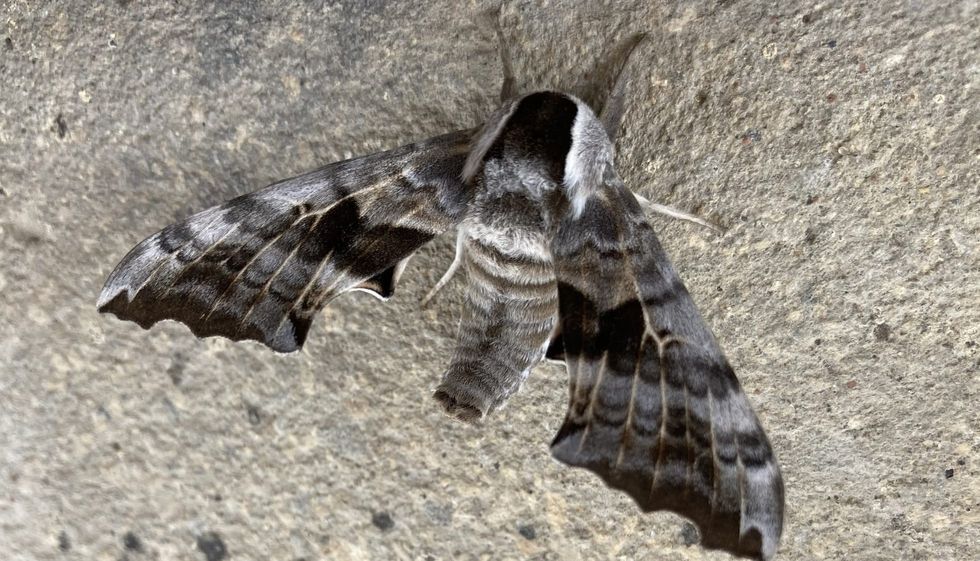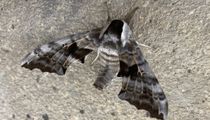The one-eyed sphinx moth is a subfamily of Sphingidae and a family of moths that are most often seen at night. These moths of North America are scientifically known as Smerinthus cerisyi and are mostly found across Michigan, southern Canada, south California, and beyond.
This particular species of moth is part of a group that has eyespots on its wings, which makes it easy to differentiate them from other moths.
The Smerinthus cerisyi sphinx is found mostly during the summer season. The species was first described in 1837 by William Kirby, who named it in honor of Alexandre Louise Lefebvre de Cerisy.
They look brownish in appearance with eyespots on their wings and are indeed a beautiful moth species. These moths are not harmful to humans, instead, they are soft to touch. When they are larvae, they feed on plants, trees, and fruits, but adults do not eat.
If butterflies and moths species interest you, keep reading, and you can also check out our puss moth and Green June beetle facts too.
One-Eyed Sphinx Moth Interesting Facts
What type of animal is a one-eyed sphinx moth?
The one-eyed sphinx moth is a moth type of animal.
What class of animal does a one-eyed sphinx moth belong to?
The one-eyed sphinx moth belongs to the Insecta class of animals.
How many one-eyed sphinx moths are there in the world?
The total number of Smerinthus cerisyi moths present in the world is unknown. Their distribution can be observed across the world, while in some regions they are more abundant than in others.
Where does a one-eyed sphinx moth live?
This moth species generally prefers to live in woodlands, since the weather and environment in this habitat are best suited for their well-being and survival.
What is a one-eyed sphinx moth's habitat?
Their distribution can be observed from Newfoundland and Maine across the northern states of America, to Michigan, southern Canada, British Columbia, Washington, and southern California. They also occur in Missouri and Tennessee. They are mostly seen during summer.
Who does a one-eyed sphinx moth live with?
Smerinthus cerisyi are generally known to live alone.
How long does a one-eyed sphinx moth live?
The lifespan of this moth is just one year long.
How do they reproduce?
Females lay oval green eggs on the leaves of trees, and the larvae that are born are green and plump with tiny white bumps all over them. These larvae then change from a green color to become paler or browner in color as they prepare to pupate in winter.
The one-eyed sphinx moth caterpillar also has a blue horn that extends from the top of its body to its rear.
They feed on plum and pear trees as they grow. The one-eyed sphinx moth lifecycle occurs just once per year.
What is their conservation status?
The conservation status of these Smerinthus cerisyi moths of North America is currently Not Evaluated.
One-Eyed Sphinx Moth Fun Facts
What does a one-eyed sphinx moth look like?
Smerinthus cerisyi moths (both males and females) are part of a group that has bright blue eyespots on their hindwings. This insect has a solitary bright blue eyespot with a large black pupil in the eyespot, located on its hindwing.
On the other hand, twin-spotted sphinx moths usually have two eyespots, and the blinded sphinx moth lacks any large black pupils.
Adults of this species can be found in a mix of dark brown and pale gray with a cross vein at the end of their discal cell. Other veins towards their outer margin are usually outlined in a paler brown color and have pink shading surrounding the blue eyespot.
They also have a blue horn from the top of their body to the rear.
One-eyed sphinx moth males are bigger than one-eyed sphinx moth females, but all one-eyed sphinx moths (both males and females) appear plump, soft, and smooth before they pupate. The presence of blue eyespots on the outer margin of each hindwing of these moths is the main feature that identifies them as Cerisy's sphinx moths.

How cute are they?
This moth species is amazing to watch and they stand out from other moth species due to their unique wing patterns. They are a cute moth species, and their unique one-eyed sphinx moth life cycle makes the species interesting too.
How do they communicate?
These moths are silent and any means of communication or sounds are undetermined and rarely heard.
How big is a one-eyed sphinx moth?
The one-eyed sphinx moth is the same size as many butterflies, it reaches a top size of 5 in (12 cm).
How fast can a one-eyed sphinx moth fly?
The exact flight speed of this species is not known, but they can be assumed to have a similar speed to many butterflies since these species are closely related to each other. Also, their speed of flight depends on the size of their wingspan.
How much does a one-eyed sphinx moth weigh?
This insect species can weigh up to 0.53 oz (15 g).
What are the male and female names of the species?
Males and females of this species do not have separate names.
What would you call a baby one-eyed sphinx moth?
The young babies of these insects are generally known as caterpillars and larvae.
What do they eat?
One-eyed sphinx moths are herbivores that feed on willow trees, poplar trees, pear, plum, and other flowers.
Are they poisonous?
No, these moths are not dangerous and they do not have a stinger like many wasps do. They are peaceful insects that move around calmly without harming anyone.
Would they make a good pet?
It is unusual to keep moths as a pet since they like to fly freely and forage food for themselves. If kept as a pet it would be too difficult to provide the correct food to eat to match their natural feeding habits.
Also, their life cycle involves a lot of complex stages that can only be experienced properly in the wild. Also, their short lifespan makes them difficult pets to keep.
Most people view these insects as pests and try to get rid of them if they appear in or near their homes. To kill sphinx moths or sphinx moth larvae you will need to use an approved insecticide that is specifically designed for this species of moth.
Did you know...
The sphinx moth species got its name from the fact that its larvae can tuck their heads underneath their body and lift their legs off the surface, forming what is generally understood as a praying position, resembling the Great Sphinx of Gaza. This is where the name 'sphinx moth' was derived from.
Are sphinx moths dangerous?
No, these moths are soft and are not naturally harmful in any way. However, some people may have an allergic reaction to this moth's small hair particles, making them sometimes toxic to consume or touch.
Therefore, even though they are not naturally dangerous insects, it is better to keep a safe distance from these animals and it is important to not touch this moth since it can cause allergic reactions, especially to people with sensitive skin.
How to distinguish a male and female one-eyed sphinx moth?
Several differences in physical descriptions of one-eyed sphinx moth males and females can be observed, this is useful when it comes to the identification of the different sexes within the species. In particular, the frenulum under their wings and the tip of their abdomen can help in distinguishing between male and female adults.
Males also have spatula-like folds of their genitalia, which are absent in females. Also, females are generally smaller than males.
Here at Kidadl, we have carefully created lots of interesting family-friendly animal facts for everyone to discover! For more relatable content, check out these common wasp facts and Mayfly facts for kids.
You can even occupy yourself at home by coloring in one of our free printable Luna moth coloring pages.
Thank you to Kidadler Daniel Davila for providing the image of the One-eyed Sphinx Moth in this article.
*Please note that the main image is of a banded sphinx moth, not a one-eyed sphinx moth. If you have any image of a one-eyed sphinx moth, please let us know at hello@kidadl.com










